In this article:
Dryness (xerosis) in the elbows is a common skin problem as the skin around the elbows is thicker and has a lower amount of protective lipids. This makes elbow skin highly prone to changes due to external factors, compromising the moisture barrier of the skin.
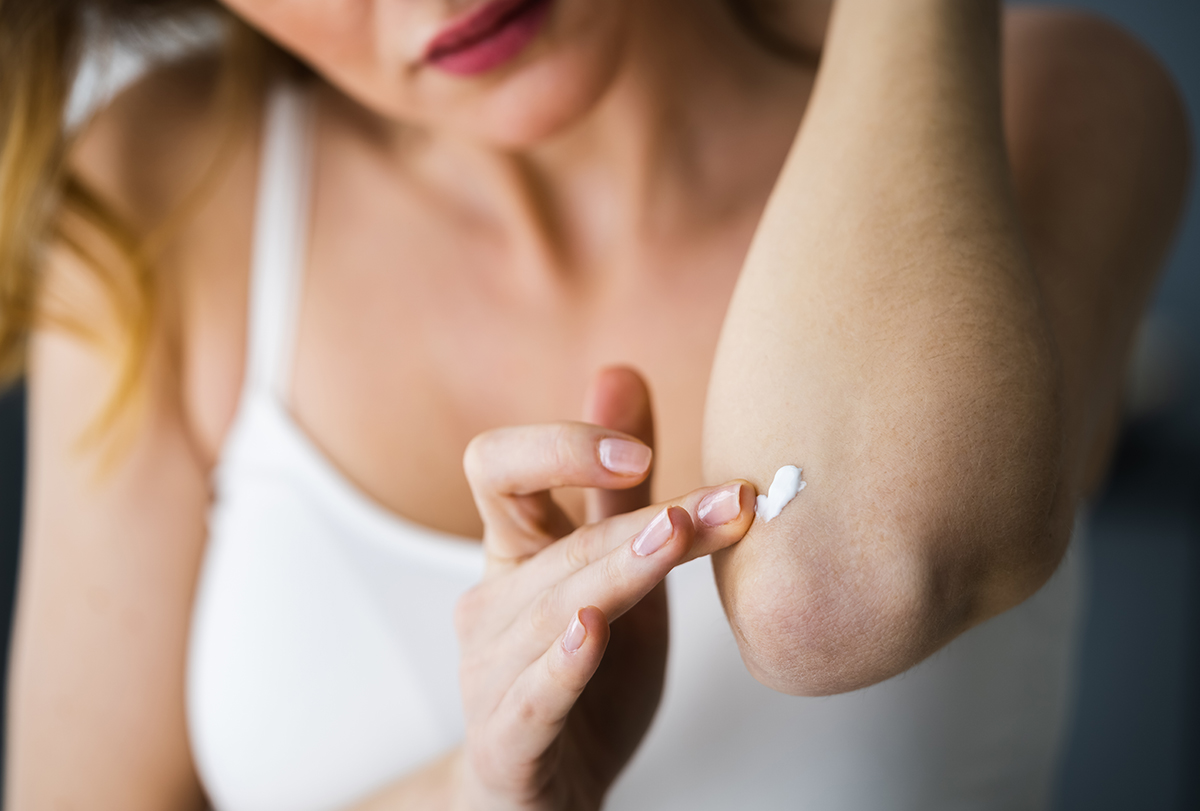
Age-related changes such as decreased cell turnover and a lack of natural moisturizing factors contribute to skin dryness. This dryness, when not addressed timely, can result in painful fissures, callosities, dermatitis, and pigmentary changes.
In addition to natural or external factors, elbow dryness can also result from skin diseases, skin irritants, or health problems such as hypothyroidism, hyperthyroidism, diabetes, and malnutrition.
Causes of Dry Elbows
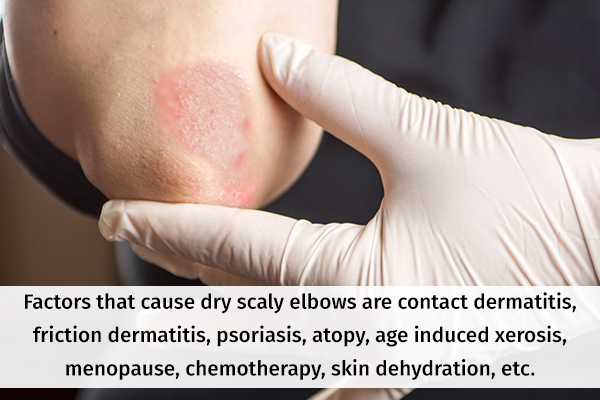
- Contact dermatitis: It is a skin inflammation disorder caused by contact with skin irritants, such as wool, and chemicals, such as fragrance parabens found in soaps, detergents, and lotions.
- Friction dermatitis: The skin on the elbows may thicken or form callosities in response to constant friction or pressure, to protect the area from damage.
- Psoriasis: It is an autoimmune condition characterized by the formation of raised silvery, scaly patches on the skin, especially around the scalp, knees, and elbows.
- Atopy: It is a genetic predisposition to have a heightened allergic response to common allergens, resulting in the development of symptoms such as dry skin or a rash on contact.
- Age-induced xerosis: With increasing age, the skin layers become thinner and its mechanical strength lowers, increasing the risk of skin dryness and formation of scales.
- Menopause: Low estrogen levels associated with menopause may lead to skin dryness.
- Chemotherapy: Treatment using chemotherapy has various side effects, including skin dryness, itching, and photosensitivity.
- Skin dehydration: A lack of natural moisturizing factors (NMF) in the skin results in a lowered ability to pull moisture from the air, leading to skin dehydration or dryness. (1)
- Environmental changes: Cold weather, low humidity levels, or indoor heating can make your skin dry by wicking moisture off the surrounding air.
- Pressure on the elbows: Prolonged resting of the elbows on a desk or pressure on the elbows during yoga can contribute to dry, scaly elbows.
- Smoking: The nicotine in cigarettes and tobacco can dry your skin and even boost the skin aging process, contributing to dry, scaly elbows.
- Harsh soaps: The use of harsh soaps, combined with excessive bathing, can remove the natural oils from your skin and cause dry, scaly elbows.
- Hot or long baths: Taking a shower with hot water can damage the protective barrier of your skin and contribute to skin dryness and scaliness.
- Overexfoliation: Excessive exfoliation can cause skin irritation and dryness, especially when using pumice stones and rough loofahs.
- Sun exposure: Excessive sun exposure can dry out your skin, wicking away the natural oils and moisture from it.
Symptoms Associated With Dry Elbows
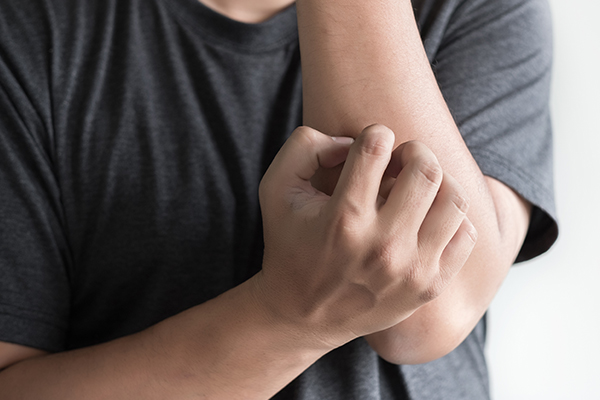
Dryness in the elbows is characterized and accompanied by the following symptoms:
- Skin fissures
- Scaly skin
- Itching
- Inflammation
- Hypo- or hyperpigmentation
- Flaking or peeling skin
- Burning pain
- Tiny water-filled vesicles in the case of eczema
- Excoriation and bleeding
Treatment for Dry Elbows

The treatment for dry, scaly elbows depends on the underlying cause. For mild cases, the doctor may only recommend a moisturizer, but for moderate to severe cases, medications may be required.
The common treatment modalities for dry scaly elbows include:
- Topical corticosteroids: Mild to moderate corticosteroids are highly helpful in treating inflammatory skin conditions such as eczema, contact dermatitis, and seborrheic dermatitis.
- Moisturizers: The doctor may recommend moisturizers that help repair the skin barrier and provide long-lasting moisturization. These include ceramide-based moisturizers that improve skin hydration, preserve skin barrier function, and lower transepidermal water loss. Urea-based moisturizers are also recommended as they prevent the accumulation of dead skin cells in addition to hydrating the skin.
- Exfoliants: The use of exfoliants to remove dead skin cells from the surface of the skin in order to reveal the fresh, young cells beneath may help in treating dry, scaly elbows. Lactic acid, with optimal biologic activity in its l-form, is used in various topical formulations to exfoliate the skin. (2) Salicylic acid-based exfoliators, which are usually used for the treatment of skin conditions such as psoriasis, are also available.
- Retinol: It promotes cell turnover, which helps in the development of new healthy cells to replace the old dead ones.
- Alpha hydroxy acids: They work by eliminating the dead skin cells from the top layers of the skin.
Diagnosing the Cause of Dry Elbows
While dry, scaly elbows are rarely a medical concern, you might need to get a proper diagnosis if the condition persists despite care and treatment.
To diagnose the cause of the skin dryness, the doctor will conduct a physical examination and take your medical history. The doctor may also order the following tests:
- Biopsy: A sample of your skin is taken to check for underlying skin disorders or skin cancer.
- Patch test: This test is performed to check the skin for allergic reactions, especially in the case of contact dermatitis.
Home Remedies for Elbow Dryness
Elbow dryness and scales are generally a mild problem that can be improved by using the following natural ingredients and simple at-home remedies.
Caution: Conduct a patch test before using any remedy to check for allergic or sensitivity reactions.
1. Apply aloe vera gel

Aloe vera is rich in antioxidants and hydrating agents that moisturize and smoothen dry, scaly elbows. It also acts as a humectant, which helps your skin retain moisture for longer. (3)
How to use:
- Apply fresh aloe vera gel to your elbows.
- Wash it off after 15 minutes.
- Repeat this remedy twice a day for best results.
2. Dab some coconut oil
Coconut oil is another excellent moisturizer that hydrates the skin and therefore can reduce skin dryness. Moreover, the use of coconut oil can help repair and renew dark damaged skin without any side effects. (4)
How to use:
- Warm some coconut oil and use it to massage your elbows. Repeat the remedy after showering and before going to bed on a daily basis.
- Alternatively, you can use almond oil in place of coconut oil.
3. Moisturize with honey
Honey possesses antioxidant, antibacterial, and hydrating properties that can relieve dry, scaly elbows caused by various causes. In fact, honey has been popularly used for the treatment of various skin disorders. (5)
In addition, the humectant properties of honey help maintain the skin’s moisture level and integrity.
How to use:
- Apply raw, organic honey on your elbows.
- Wash it off with warm water after 20 minutes.
- Repeat this remedy twice a day for best results.
4. Use turmeric paste
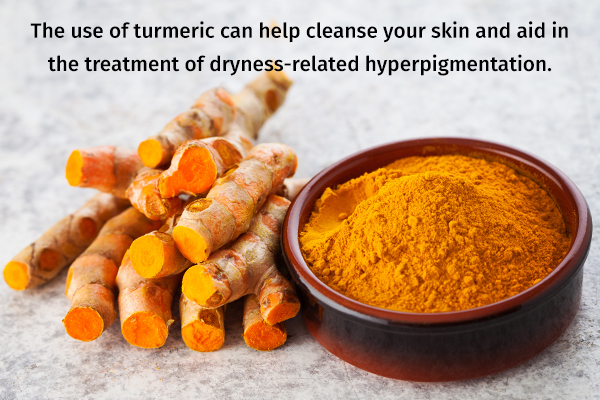
Turmeric is loaded with skin-beneficial properties, and its active compound, curcumin, exhibits antimicrobial, anti-inflammatory, and antioxidant activities that are useful in the treatment of various dermatological problems.
Moreover, the use of turmeric helps cleanse your skin and aids in the treatment of dryness-related hyperpigmentation. (6) You can use turmeric with milk and honey for their moisturizing properties.
How to use:
- Mix milk, honey, and turmeric powder to form a paste.
- Apply the paste to your elbows and massage it in for a few minutes.
- Rinse it off after 10–15 minutes.
5. Take an oatmeal bath
Oatmeal can be used to exfoliate your skin mildly, removing dead skin cells and leaving your skin smooth and soft. The exfoliating properties of colloidal oatmeal make it a common ingredient in various personal care products, without the risk of allergies. (7)
How to use:
- Add 1 cup of oats to your bathwater and soak in it for 20 minutes.
- Rinse your body with fresh water, pat your skin dry, and apply a moisturizer.
- Repeat this remedy daily for best results.
6. Rub a banana peel
Banana peels have been anecdotally used in the treatment of skin dryness. It is suggested that the fatty acid content of banana peels can help moisturize the skin, while its antioxidants help lighten dark skin. However, there is no scientific research to support the use of banana peel for skin dryness.
How to use:
- Rub the inside of a banana peel on your elbows for up to 10 minutes in gentle, circular motions.
- Wash your skin after 20 minutes.
Lifestyle Changes for Dry Elbows
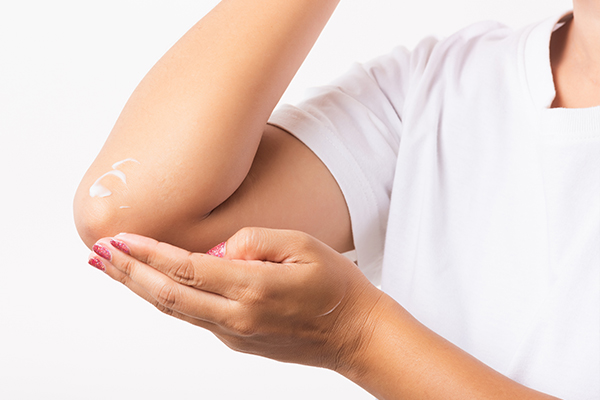
Aside from medical treatment or at-home remedies, the following lifestyle changes are also necessary to support treatment and prevent aggravation of the condition:
- Do not take long showers. Limiting your bath or shower time, especially when using hot water, is essential to prevent skin dryness.
- Use pH-balanced shower gels. These skin-friendly products help restore skin pH, helping moisturize, soften, and soothe your skin.
- Avoid rubbing your skin. Use elbow pads if you are resting your elbows on any surface for long periods to prevent friction. Moreover, make sure to pat dry your skin instead of rubbing it with a towel.
- Moisturize. Make sure to apply a moisturizer after taking a shower, preferably when your skin is slightly wet, to help lock in the moisture.
- Use petroleum jelly. You can apply petroleum jelly to your elbows to help control dryness and itching.
- Maintain stress. Stress is a common trigger for atopic dermatitis. Therefore, using stress management techniques such as yoga and meditation can help prevent eczema flare-ups.
- Use a humidifier. Turn on your indoor humidifier to keep the air humid, especially in the dry winter months.
How to Prevent Dry Elbows
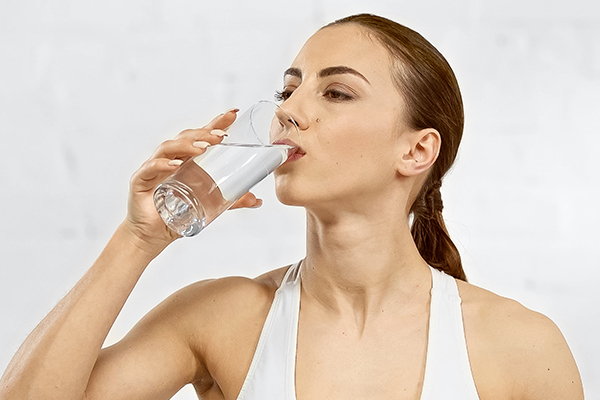
The following tips may be helpful in preventing dry, scaly elbows:
- Use suitable skin products: Avoid the use of harsh skin care products. Use soaps and deodorants that are paraben-free. Similarly, avoid colognes, after-bath splashes, and aftershaves that contain alcohol.
- Protect your skin from the sun: Apply a broad-spectrum sunscreen with SPF 30 or higher to prevent sun damage to your skin. You can opt for sunscreens that are plant oil or fruit butter based as they also help nourish and hydrate the skin.
- Drink plenty of water: it is vital to stay hydrated to keep your skin moisturized from within.
- Avoid public hot tubs and pools: The water in hot tubs and swimming pools is laden with chemicals such as chlorine, which can irritate your skin. If going swimming, apply olive oil to your skin, especially the dry areas. This not only helps moisturize the skin but also forms a protective barrier on the skin surface, preventing it from absorbing chlorine.
- Wear soft clothing: It is recommended to wear clothes made of cotton material instead of wool, acrylic, or polyester.
Final Word
Dry elbows are a mild problem, but they can be bothersome, especially if they persist. It is recommended to make lifestyle changes to take care of the problem at the earliest. This can be done by applying suitable lotions, shortening your bath time, and exfoliating your skin weekly, among others.
However, if the problem does not improve, you can use over-the-counter medicated products or visit your doctor for a proper diagnosis and treatment, especially if you suspect any underlying medical condition.
- Was this article helpful?
- YES, THANKS!NOT REALLY


